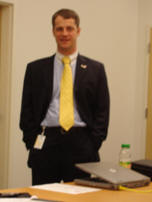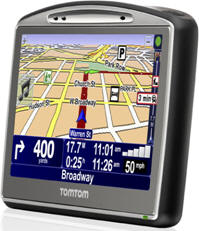 Ed.
note: Two factual errors were corrected in this article after its
publication. The support company's name is Stream International, not
Spring International. The in-dash device in the rental car was supplied by
Honda, not TomTom. TomTom does not offer in-dash systems.
Ed.
note: Two factual errors were corrected in this article after its
publication. The support company's name is Stream International, not
Spring International. The in-dash device in the rental car was supplied by
Honda, not TomTom. TomTom does not offer in-dash systems.On June 21st, I attended a day-long press event at TomTom's Watertown, New York offices to talk about the company's vision and customer support. I also previewed TomTom's new product, the TomTom GO 720. In addition to the TomTom staff, personnel from Tele Atlas and Stream International were also in attendance. Tele Atlas is TomTom's primary data vendor - and as of Monday, July 23, their potential new acquisition. Stream International is the company that provides TomTom's primary customer support.
Unique to this presentation was the fact that the new product demo was given by the company president, Jocelyn Vigreux.
TomTom is the world's largest provider of personal navigation devices. These are devices that provide maps, navigation, traffic and weather, and interface with a cell phone, car stereo, I-Pod and PC.
 |
When I arrived in Syracuse, New York, I was supplied with a rental car that was equipped (not surprisingly) with a built-in navigation system. Naturally, I used it to get to Watertown and the hotel. The experience provided me a great opportunity to compare the old technology with TomTom's latest personal navigation device, the GO 720. While the rental car's map rendering and user interface were good, I found out the next day that they were nowhere near as good as the GO 720.
The press presentation covered four areas: an overview of TomTom as a company, the new GO 720, Tele Atlas, and the scope of Stream International's customer service. After a quick company overview, Vigreux discussed the primary innovations that he feels set TomTom apart from the competition. These included: incorporating Bluetooth, hands-free calling, rechargeable batteries, a 100% touch-screen interface, U.S. and European pre-loaded maps and quick GPS fix, among others.
We got to play (briefly) with the new GO 720 and, magically, they had one in the vehicle that took us to dinner. I will have an opportunity in the future to try one in my own vehicle, and I plan to provide a more detailed review after that. In the meantime, here are the specs and an image so you can see what it looks like.
 |
- 4.3" widescreen 16:9 format LCD (WQVGA: 480*272 pixels)
- CPU 400 MHz, 64MB RAM
- Maps of US and Canada preloaded on 2GB internal flash memory
- SD card slot
- High sensitivity GPS receiver
- RDS-TMC traffic information receiver (optional accessory, not included)
- Integrated FM transmitter
- Bluetooth
- Lithium-polymer battery (5 hours operation)
- Optimized integrated microphone and speaker for high quality hands-free functionality
- Dimensions: 4.7" x 3.2" x 0.9"
- Weight: 7.7 ounces
Data Gathering with Tele Atlas
We took a ride in the Tele Atlas minivan, which is chock-full of data-gathering equipment, including a LIDAR device on the roof. In fact, there is only room for three passengers (including the driver). As the van drives down the street, imagery is captured and displayed as multiple images on a large LCD screen. The driver monitors the data capture as it is stored on a large hard drive in the rear of the van. The LIDAR data are used to reference buildings and other structures so the captured environment can be measured.
 |
Customer Service
The meeting took place in Watertown because it is the location of TomTom's primary customer service center. We learned about Stream International's scope of support, which includes 9,000 calls and e-mails per week and 500,000 call minutes per month. Each support person has at least 80 hours of training in the products, and there are a total of 120 support personnel on staff.
The instruction includes training on each TomTom device, using computer screens that simulate all the products. In addition, there is a repository of actual devices so personnel can “touch and feel" a device, if needed. Stream International also supports other companies, but the area dedicated to TomTom includes dozens of cubicles. Tom Read, the site director, showed us the support stations, the training facilities and even spoke about employee rewards, support and motivation.
TomTom is a rapidly growing company that offers sophisticated mapping technology for the average person. By integrating cell phones, the car's stereo and even Bluetooth, the customer gets easy access to much more than just directions. Combined with topnotch data and solid support, it's an impressive package.